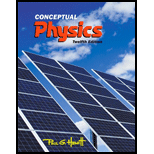
Conceptual Physics / MasteringPhysics (Book & Access Card)
12th Edition
ISBN: 9780321908605
Author: Paul G. Hewitt
Publisher: PEARSON
expand_more
expand_more
format_list_bulleted
Concept explainers
Question
Chapter 33, Problem 20RCQ
To determine
The detector which senses flashes of light produced by charged particle or gamma rays.
Expert Solution & Answer
Want to see the full answer?
Check out a sample textbook solution
Students have asked these similar questions
Can someone help me with this physics 2 problem thank you.
Can someone help me with this physics 2 problem thank you.
Can someone help me with this physics 2 problem thank you.
Chapter 33 Solutions
Conceptual Physics / MasteringPhysics (Book & Access Card)
Ch. 33 - Prob. 1RCQCh. 33 - Prob. 2RCQCh. 33 - Prob. 3RCQCh. 33 - Prob. 4RCQCh. 33 - Prob. 5RCQCh. 33 - Prob. 6RCQCh. 33 - Prob. 7RCQCh. 33 - Prob. 8RCQCh. 33 - Prob. 9RCQCh. 33 - Prob. 10RCQ
Ch. 33 - Prob. 11RCQCh. 33 - Prob. 12RCQCh. 33 - Prob. 13RCQCh. 33 - Prob. 14RCQCh. 33 - Prob. 15RCQCh. 33 - Prob. 16RCQCh. 33 - Prob. 17RCQCh. 33 - Prob. 18RCQCh. 33 - Prob. 19RCQCh. 33 - Prob. 20RCQCh. 33 - Prob. 21RCQCh. 33 - Prob. 22RCQCh. 33 - Prob. 23RCQCh. 33 - Prob. 24RCQCh. 33 - Prob. 25RCQCh. 33 - Prob. 26RCQCh. 33 - Prob. 27RCQCh. 33 - Prob. 28RCQCh. 33 - Prob. 29RCQCh. 33 - Prob. 30RCQCh. 33 - Prob. 31RCQCh. 33 - Prob. 32RCQCh. 33 - Prob. 33RCQCh. 33 - Prob. 34RCQCh. 33 - Prob. 35RCQCh. 33 - Prob. 36RCQCh. 33 - Prob. 37RCQCh. 33 - Prob. 38RCQCh. 33 - Prob. 39RCQCh. 33 - Prob. 40RCQCh. 33 - Prob. 41RCQCh. 33 - Prob. 42RCQCh. 33 - Prob. 43RCQCh. 33 - Prob. 44RCQCh. 33 - Prob. 45RCQCh. 33 - Prob. 46RCQCh. 33 - Prob. 47RCQCh. 33 - Prob. 48RCQCh. 33 - Prob. 49RCQCh. 33 - Prob. 50RCQCh. 33 - Prob. 51RCQCh. 33 - Prob. 52RCQCh. 33 - Prob. 53RCQCh. 33 - Prob. 54RCQCh. 33 - Prob. 55RCQCh. 33 - Prob. 56RCQCh. 33 - Prob. 57RCQCh. 33 - Prob. 58RCQCh. 33 - Prob. 59RCQCh. 33 - Prob. 60RCQCh. 33 - Prob. 61RCQCh. 33 - Prob. 62RCQCh. 33 - Prob. 63RCQCh. 33 - Prob. 64RCQCh. 33 - Prob. 65RCQCh. 33 - Prob. 66RCQCh. 33 - Prob. 67RCQCh. 33 - Prob. 68RCQCh. 33 - Prob. 69RCQCh. 33 - Prob. 70RCQCh. 33 - Prob. 71RCQCh. 33 - Prob. 72RCQCh. 33 - Prob. 73RCQCh. 33 - Prob. 74RCQCh. 33 - Prob. 75RCQCh. 33 - Prob. 76RCQCh. 33 - Prob. 77RCQCh. 33 - Prob. 78RCQCh. 33 - Prob. 79RCQCh. 33 - Prob. 80RCQCh. 33 - Prob. 81RCQCh. 33 - Prob. 82RCQCh. 33 - Prob. 83RCQCh. 33 - Prob. 84RCQCh. 33 - Prob. 85RCQCh. 33 - Prob. 86RCQCh. 33 - Prob. 87RCQCh. 33 - Prob. 88RCQCh. 33 - Prob. 89RCQCh. 33 - Prob. 90RCQ
Knowledge Booster
Learn more about
Need a deep-dive on the concept behind this application? Look no further. Learn more about this topic, physics and related others by exploring similar questions and additional content below.Similar questions
- Explain how centripetal acceleration is affected when the hanging mass changes. Does the graph verify the relationship in equation r = x i + y j = r cosθi + r sinθj?arrow_forwardCan someone help me with this physics 2 problem thank you.arrow_forwardCan someone help me with this physics 2 problem thank you.arrow_forward
arrow_back_ios
SEE MORE QUESTIONS
arrow_forward_ios
Recommended textbooks for you
 College PhysicsPhysicsISBN:9781305952300Author:Raymond A. Serway, Chris VuillePublisher:Cengage Learning
College PhysicsPhysicsISBN:9781305952300Author:Raymond A. Serway, Chris VuillePublisher:Cengage Learning University Physics (14th Edition)PhysicsISBN:9780133969290Author:Hugh D. Young, Roger A. FreedmanPublisher:PEARSON
University Physics (14th Edition)PhysicsISBN:9780133969290Author:Hugh D. Young, Roger A. FreedmanPublisher:PEARSON Introduction To Quantum MechanicsPhysicsISBN:9781107189638Author:Griffiths, David J., Schroeter, Darrell F.Publisher:Cambridge University Press
Introduction To Quantum MechanicsPhysicsISBN:9781107189638Author:Griffiths, David J., Schroeter, Darrell F.Publisher:Cambridge University Press Physics for Scientists and EngineersPhysicsISBN:9781337553278Author:Raymond A. Serway, John W. JewettPublisher:Cengage Learning
Physics for Scientists and EngineersPhysicsISBN:9781337553278Author:Raymond A. Serway, John W. JewettPublisher:Cengage Learning Lecture- Tutorials for Introductory AstronomyPhysicsISBN:9780321820464Author:Edward E. Prather, Tim P. Slater, Jeff P. Adams, Gina BrissendenPublisher:Addison-Wesley
Lecture- Tutorials for Introductory AstronomyPhysicsISBN:9780321820464Author:Edward E. Prather, Tim P. Slater, Jeff P. Adams, Gina BrissendenPublisher:Addison-Wesley College Physics: A Strategic Approach (4th Editio...PhysicsISBN:9780134609034Author:Randall D. Knight (Professor Emeritus), Brian Jones, Stuart FieldPublisher:PEARSON
College Physics: A Strategic Approach (4th Editio...PhysicsISBN:9780134609034Author:Randall D. Knight (Professor Emeritus), Brian Jones, Stuart FieldPublisher:PEARSON

College Physics
Physics
ISBN:9781305952300
Author:Raymond A. Serway, Chris Vuille
Publisher:Cengage Learning

University Physics (14th Edition)
Physics
ISBN:9780133969290
Author:Hugh D. Young, Roger A. Freedman
Publisher:PEARSON

Introduction To Quantum Mechanics
Physics
ISBN:9781107189638
Author:Griffiths, David J., Schroeter, Darrell F.
Publisher:Cambridge University Press

Physics for Scientists and Engineers
Physics
ISBN:9781337553278
Author:Raymond A. Serway, John W. Jewett
Publisher:Cengage Learning

Lecture- Tutorials for Introductory Astronomy
Physics
ISBN:9780321820464
Author:Edward E. Prather, Tim P. Slater, Jeff P. Adams, Gina Brissenden
Publisher:Addison-Wesley

College Physics: A Strategic Approach (4th Editio...
Physics
ISBN:9780134609034
Author:Randall D. Knight (Professor Emeritus), Brian Jones, Stuart Field
Publisher:PEARSON